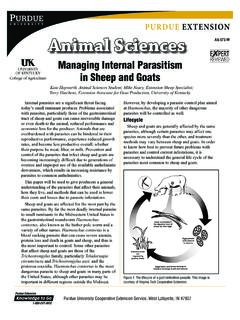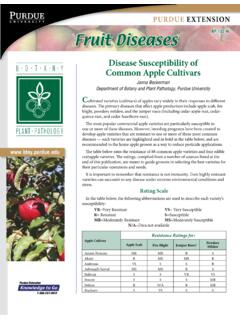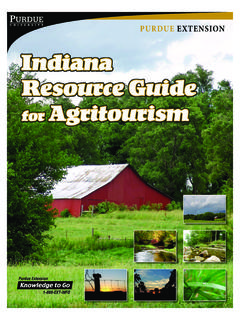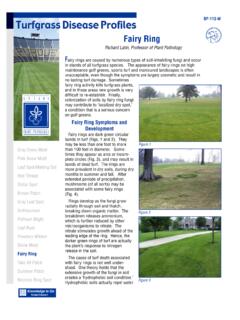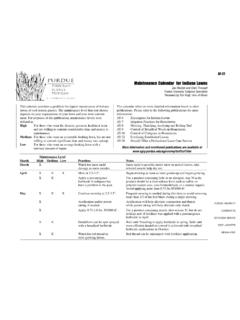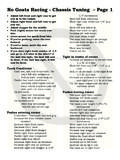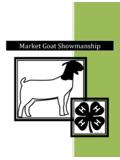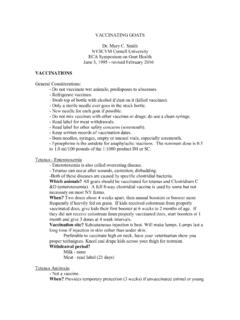Transcription of Common Diseases and Health Problems in Sheep …
1 Common Diseases and Health Problems in Sheep and GoatsLynn Pezzanite, Animal Sciences Student, Purdue UniversityDr. Michael Neary, Extension Small Ruminant Specialist, Purdue UniversityTerry Hutchens, Extension goat Specialist, Univ. of KentuckyDr. Patty Scharko, Extension Veterinarian, University of KentuckyP u r d u e e x t e n s i o nAS-595-WAnimal SciencesPurdue University Cooperative Extension Service, West Lafayette, IN 47907A sound management program to keep animals healthy is basic to production of both Sheep and goats. Producers must observe animals closely to keep individual animals and the whole herd or flock healthy and productive. If the heath status of a herd is compromised, that operation will not be as efficient as possible.
2 There are some human Health risks when dealing with diseased animals. While most Diseases affecting Sheep and goats do not pose any human Health risks, some are zoonotic and it is important to protect not only caretakers, but anyone else that may come in contact with diseased animals. Sheep and goats share many Health Problems . While there are some important differences between the species, this publication gives a broad overview of Diseases and Health Problems . For further information on specific Diseases , references and sources of additional information are available at the end of this document. Evaluating Animal Health StatusTo recognize clinical signs of Diseases Common to Sheep and goats, it is important to be familiar with what is normal.
3 Producers should assess the herd or flock s general Health on a regular basis, including vital signs, body condition, and coat. A normal temperature range for Sheep and goats is between F and F. The respiration rate for Sheep and goats is about 12 to 15 breaths per minute (depending on environmental temperature), and heart rate should be between 70 and 80 beats per minute. Animals should exhibit a healthy hair coat or fleece, while maintaining a body condition score appropriate to their production stage. Both coat and body condition score are good indications of nutritional adequacy and overall Health . Signs of an unhealthy animal include isolation from the rest of the herd/flock, abnormal eating habits, depression, scouring or diarrhea, abnormal vocalization, teeth grinding, or any other abnormal of DiseaseBiosecurity begins with the goal of preventing the spread of infectious agents from infected to susceptible animals.
4 A biosecurity plan must take into account all modes of transmission, including direct animal contact within a herd, contact with wild animals or other domesticated species, airborne transmission, contaminated feed or water, and visitors or vehicles that come onto the farm. The most basic method of disease control in individual herds/flocks is to avoid introduction of disease agents. If possible and practical, producers should keep a closed herd/flock. Most Diseases of a contagious nature are introduced into operations when new animals are added. disease agents can be introduced when breeding animals are added to an operation; when animals co-mingle at a fair, show or sale; or when animals contact wildlife.
5 If a closed herd/flock is not feasible, then use an animal quarantine program. A useful isolation program consists of a facility that prevents co-mingling of animals for at least 30 days, including separate water supplies. Purdue Extension Knowledge to Go2 Common Diseases and Health Problems in Sheep and Goats AS-595-W Restricting traffic in and out of a facility can reduce the potential introduction of pathogenic agents. Producers should minimize the number of people and vehicles that enter premises or require a sanitation and disinfectant plan to prevent spread of disease agents. Other important management tasks that can prevent or help minimize disease issues are sanitation of facilities (especially shared livestock trailers), good ventilation or air turnover, proper stocking or animal density rates, and a good nutrition program.
6 Utilizing a VeterinarianMany Sheep and goat producers complain that they cannot find a veterinarian who is knowledgeable or interested in Sheep and goats. Some veterinarians are very interested in small ruminants and act as important resources for producers. Producers share some of the blame for not attracting knowledgeable animal Health professionals to practices that include Sheep and goats. Too often, producers only utilize a veterinarian when they have an emergency. Often, these emergency situations do not turn out as successfully as the veterinarian or the producer would like. However, producers can adopt strategies to attract a veterinarian to service their animal- Health needs. First they should cultivate a relationship with the veterinarian as a trained professional to help in whole-herd Health maintenance and not just as a source of free information or emergency service.
7 Proactive management tasks such as breeding soundness exams on rams or bucks, tailoring a vaccination program to the producer s farm, purchasing supplies and vaccines from the vet, and using their services for other animals such as household pets are just a few examples. Additionally, producers can work together to obtain services from a veterinarian. Producers who coordinate with other Sheep and goat producers in a geographic region are more likely to attract the attention of a veterinarian who is interested in Sheep and goats. Advice and treatment from a veterinarian is almost an absolute in preventing and controlling Health Problems in a herd/flock. Veterinarians can recommend vaccination programs; help with parasite control programs; assist with reproductive management; deal with emergency situations; prescribe drugs that may be useful, but are not approved for Sheep or goats; do necropsies on dead animals; and perform a host of other important management Programs Vaccinating the herd/flock can provide some insurance against specific Common Diseases .
8 However, each vaccination program must be tailored to an individual operation. It is also important that producers understand what they are vaccinating for and why it is important. This is another instance where a veterinarian s assistance can be critical. Just because there is a vaccine available for a specific disease does not mean producers should use it. There should be economic or other justification to vaccinate for specific Diseases . Producers should work through the risk factors and other control programs with a veterinarian and decide whether or not it makes sense to vaccinate. The clostridial vaccines are the only ones that can be recommended on a blanket basis for almost all Sheep and goats.
9 All other vaccination programs need to be developed specific to a herd/flock. Sheep and goats should be vaccinated for Clostridium perfringens Types C and D and tetanus (CD&T) at appropriate times. Combination vaccines (7- and 8-way) are also available against other clostridial Diseases , such as blackleg and malignant edema. These vaccines are inexpensive, and when used properly, are very effective in preventing losses. Clostridial Diseases are endemic to all Sheep and goat operations. They are caused by specific bacteria that commonly live in the gut and manure of Sheep and goats and, under specific conditions, can affect both Sheep and goats. More information on these Diseases will be discussed in the next section.
10 When handling vaccinations, it is important to follow label directions, as vaccines must be stored, handled, and administered properly. Only healthy livestock should be DiseasesEnterotoxemia Type C, or bloody scours, can occur in two distinct forms. The first form, known as struck, is seen in adults that do not normally exhibit clinical signs. Ulcerations of the small intestine are noted upon necropsy. The second form, known as enterotoxic hemorrhagic enteritis, occurs in lambs or kids within the first few days of life. It causes an infection of the small intestine, resulting in bloody diarrhea or sometimes death without clinical signs. Enterotoxemia is often related to indigestion. It is predisposed by an overabundance of milk, possibly due to the loss of a twin.
